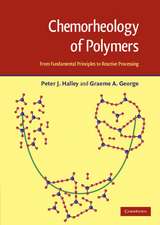Biocatalysis: Van Nostrand Reinhold Electrical/Computer Science and Engineering Series
Editat de D.A. Abramowiczen Limba Engleză Paperback – 8 iul 2012
Preț: 392.97 lei
Nou
Puncte Express: 589
Preț estimativ în valută:
75.20€ • 77.69$ • 62.59£
75.20€ • 77.69$ • 62.59£
Carte tipărită la comandă
Livrare economică 25 martie-08 aprilie
Preluare comenzi: 021 569.72.76
Specificații
ISBN-13: 9789401091268
ISBN-10: 9401091269
Pagini: 400
Ilustrații: XXVIII, 400 p. 24 illus.
Dimensiuni: 152 x 229 x 21 mm
Greutate: 0.53 kg
Ediția:Softcover reprint of the original 1st ed. 1990
Editura: SPRINGER NETHERLANDS
Colecția Springer
Seria Van Nostrand Reinhold Electrical/Computer Science and Engineering Series
Locul publicării:Dordrecht, Netherlands
ISBN-10: 9401091269
Pagini: 400
Ilustrații: XXVIII, 400 p. 24 illus.
Dimensiuni: 152 x 229 x 21 mm
Greutate: 0.53 kg
Ediția:Softcover reprint of the original 1st ed. 1990
Editura: SPRINGER NETHERLANDS
Colecția Springer
Seria Van Nostrand Reinhold Electrical/Computer Science and Engineering Series
Locul publicării:Dordrecht, Netherlands
Public țintă
ResearchCuprins
1 The Archeology of Enzymology.- Early Highspots.- Confession of a Peroxidase Addict.- Gastric Juice: A Hearty Brew.- What Is Catalysis?.- Anticipating an Enzyme.- Some Early Enzyme Patents.- Water-Insoluble Enzymes Can Work Too.- Chemical Modification of Enzymes.- Enzymes in Organic Solvents Can Go Either Way.- Publication Velocity: A Survival Factor.- Enzyme Specificity: An Intellectual Caldron.- Developments over Time.- An Example of Serendipity in Scientific Discovery.- Time and the Cytochromes: Termination and Resuscitation.- Effect of Temperature on Fat Unsaturation.- Conclusions.- 2 Synthesis of Polyesters by Lipase-Catalyzed Polycondensation in Organic Media.- Oligomer and Polymer Synthesis with Hydrolases.- Formation of [AA-BB]x Polyesters by Lipase-Catalyzed Transesterification.- Enzymatic Synthesis of an Optically Active Polyester.- Conclusions.- 3 Regiospecific Hydroxylation of Biphenyl and Analogs by Aspergillus parasiticus.- Materials and Methods.- Results and Discussions.- Conclusions.- 4 Simple Carbohydrates as Starting Materials in Organic Synthesis: A Comparison of Strategies.- Chemical Synthesis.- Immobilized Enzyme Synthesis.- Microbial Whole Cell Synthesis.- Final Results.- 5 The Production of Amino Acids by Transamination.- Mechanism of Transamination 116 Advantages and Disadvantages of Transaminases for Biocatalytic Reactions.- Driving the Reaction to Completion 120 Production of Amino Acids Using the Aspartic Transaminase from E. Coli.- Immobilization of the Transaminase.- Production of Branched-Chain l-Amino Acids.- Enzyme Production.- Conclusion.- 6 A Biocatalytic Approach to Vitamin C Production: Metabolic Pathway Engineering of Erwinia herbicola.- Historical Perspective.- Recombinant Strategy.- Development of the Recombinant Bacterial Strain.- Carbohydrate Metabolism in the Recombinant Strains.- Conclusions.- 7 Chiral Synthons by Biocatalysis.- Background of Dehalogenase Enzymes.- Dehalogenase Technology.- 8 Enzymatic Resolution of Ibuprofen in a Multiphase Membrane Reactor.- Enzyme-Substrate Screening.- Multiphase Membrane Bioreactor-Theory of Operation.- Results and Discussion.- Conclusions.- 9 Microbial Reduction of Carbonyl Compounds: A Way to Pheromone Synthesis.- What Is a Pheromone?.- Methodology.- Chiral Alcohols or Derivatives.- Chiral Ketones.- Conclusion.- 10 Resolution of Binaphthols and Spirobiindanols Using Pancreas Extracts.- Results.- Discussion.- Experimental Section.- 11 Chiral Synthons by New Oxidoreductases and Methodologies.- What Is Meant by “New” Enzymes and Methodologies?.- Practical Aspects.- Regeneration of Viologens.- Hydrogenations with C. Tyrobutyricum Containing Hydrogenase and Enoate Reductase.- 2-Hydroxycarboxylate Viologen Oxidoreductase and Its Use for the Preparation of (2R)-Hydroxycarboxylates.- Dehydrogenation of (2R)-Hydroxycarboxylates from Racemic Mixtures for the Preparation of (2S)-Hydroxycarboxylates.- Preparation of Chiral Deuterated Compounds.- Reductions of Hydroxylamines.- Example of a Viologen-Dependent Pyridine Nucleotide Oxidoreductase.- Carboxylate Reduction with Clostridia and Carbon Monoxide.- 12 Enzymes from Extreme Environments.- Protein Stability.- Thermostable Enzymes.- Recombinant Thermostable Enzymes.- Future Applications.- 13 Biocatalysis in Anaerobic Extremophiles.- Acidoanaerobes.- Haloanaerobes.- Thermoanaerobes.- Alcohol Dehydrogenase.- Amylases.- Xylose (Glucose) Isomerase.- Summary.- 14 Large-Scale Bioconversion of Nitriles into Useful Amides and Acids.- Biotechnical Potential of Nitrile Metabolism.- Production of Acrylamide withPseudomonas Chlororaphis B23 Nitrile Hydratase.- Characterization and Cofactors of Iron-Containing Nitrile Hydratase.- Occurrence of a Cobalt-Induced and Cobalt-Containing Nitrile Hydratase in Rhodococcus Rhodochorous J1.- Production of Nicotinamide with R. Rhodochrous J1 Nitrile Hydratase.- Production of Nicotinic Acid with R. Rhodochrous J1 Nitrile.- 15 Aldolases in Organic Synthesis.- Fructose-1,6-Diphosphate Aldolase (FDP Aldolase).- Synthesis.- Thermodynamically Controlled C-C Bond Formation.- N-Acetylneuraminic Acid Aldolase (Neu5Ac Aldolase).- 16 Two-Liquid Phase Biocatalysis: Reactor Design.- Nomenclature.- Experimental Determination of Reactor Design Parameters.- Example: Benzyl Acetate Hydrolysis by Pig Liver Esterase.- Optimal Reactor Operation.- Reactor Design and Scale-Up.- Process Design.- Conclusions.- 17 Enzymes That Do Not Work in Organic Solvents: Too Polar Substrates Give Too Tight Enzyme-Product Complexes.- Discussion.
Recenzii
This useful and interesting book, with a subject index and chapter summaries. The concluding chapter by antonies Kieboom is a particularly thoughtful analysis of why carbohydrate-converting enzymes may be catalytically inactive in water-free solvents, unless the product is much less popular than the substrate. It is suggested here that a too tight enzyme-substrate or enzyme- product complex is formed in a apolar organic solvent. Chemistry and Industry; This useful and interesting book, with a subject index and chapter summaries. The concluding chapter by antonies Kieboom is a particularly thoughtful analysis of why carbohydrate-converting enzymes may be catalytically inactive in water-free solvents, unless the product is much less popular than the substrate. It is suggested here that a too tight enzyme-substrate or enzyme- product complex is formed in a apolar organic solvent. Chemistry and Industry





















